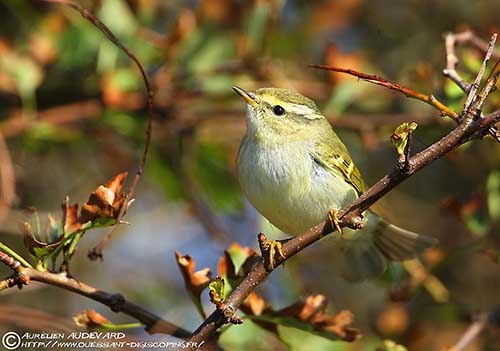
Fr: Pouillot à grands sourcils
Ang: Yellow-browed Warbler
All: Gelbbrauen-Laubsänger
Esp: Mosquitero Bilistado
Ita: Luì forestiero
Nd: Bladkoning
Sd: tajgasångare
Photographers:
John Anderson
John Anderson Photo Galleries
Aurélien Audevard
OUESSANT DIGISCOPING
Didier Buysse
Vision d’Oiseaux
Ken Havard
My Bird Gallery & Flickr gallery 1 & Flickr gallery 2
Text by Nicole Bouglouan
Sources:
HANDBOOK OF THE BIRDS OF THE WORLD Vol 11 by Josep del Hoyo, Andrew Elliott and David Christie - Lynx Edicions - ISBN: 849655306X
THE HANDBOOK OF BIRD IDENTIFICATION FOR EUROPE AND THE WESTERN PALEARCTIC by Mark Beaman, Steve Madge - C. Helm - ISBN: 0713639601
Hidden leks in the Yellow-browed Warbler Phylloscopus inornatus?
Wikipedia, the free encyclopaedia
What Bird-The ultimate Bird Guide (Mitchell Waite)
Birdwatch - The home of birding
Yellow-browed Warbler
Phylloscopus inornatus
Passeriformes Order – Phylloscopidae Family
INTRODUCTION:
The Yellow-browed Warbler is now a full species after a recent study. Actually, P. inornatus and P. humei show significant differences in both behaviour and vocalizations. Formerly included in the Old World assemblage in the family Sylviidae, the Yellow-browed Warbler is now in the family Phylloscopidae.
Members of genus Phylloscopus are often very similar to one another, and some are really difficult to identify. They are usually long-distance migrants.
The Yellow-browed Warbler breeds in temperate Asia and winters S in tropical SE Asia and small numbers in W Europe. It frequents a wide variety of broadleaf woodlands where it breeds, whereas during winter, it frequents more open habitats, usually below 1500 metres of elevation.
The Yellow-browed Warbler has stable population and is not globally threatened.

DESCRIPTION OF THE BIRD:
Biometrics:
Length: 10-11 cm
Weight: 4,3-6,5 g
The Yellow-browed Warbler has olive-green upperparts with slightly duller crown. On the upperwing, two whitish wingbars are formed by the pale tips of median and greater coverts. Flight feathers and rectrices are brown with bright greenish edges. The tertials have pale yellowish edges, and the secondaries are narrowly white-tipped.
The underparts are creamy-white, with sometimes a pale yellowish tinge on flanks and undertail-coverts.
On the head, there is a conspicuous, long, whitish to pale yellowish supercilium, giving the species its name. A narrow, blackish eye line extends from lores, through the eye to the ear-coverts. The crown is dull olive-green. The cheeks are yellowish-olive. Chin and throat are whitish.
The bill is blackish with yellow base of lower mandible. The eyes are dark brown. The legs are blackish-brown to grey-brown, with yellower feet.
Male and female are similar.
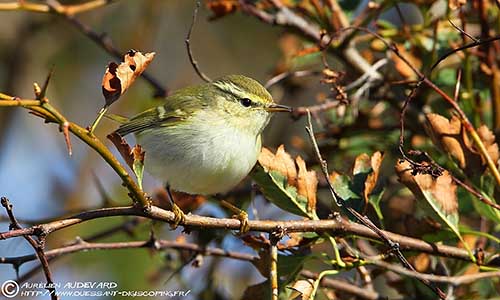
The juvenile resembles adult, but it is mostly brownish-olive above with darker crown. Flight feathers and tail are dark brown with narrow pale edges. The wing-coverts have pale yellowish tips. The whitish underparts are partially washed with yellow.
RANGE:
The Yellow-browed Warbler breeds in N Russia to E Siberia, S to NE Altai, NW Mongolia, Baikal Mts and NE China. Outside the breeding season, it is found in NE Indian subcontinent, E to SE Asia and Taiwan.
It is a regular vagrant to Europe with small numbers in W Europe, Iceland, France, Portugal, Britain, Netherlands, Madeira, Canary Islands, N and W Africa, Cyprus, Kuwait, Borneo and Sumatra.
Ouessant
France
Ouessant
France
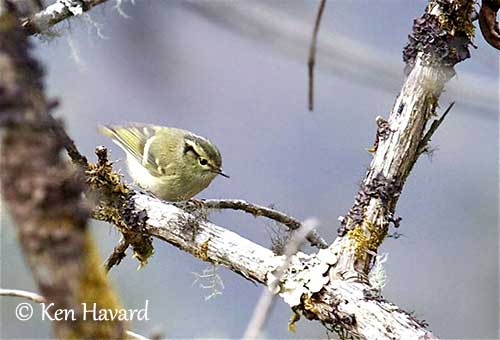
HABITAT:
The Yellow-browed Warbler breeds in forests (deciduous, mixed or coniferous) including various tree species. It breeds in mountain forests between 1000 and 2400 metres of elevation. In the southern part of the range, it favours stunted tree species and shrubs.
After the breeding season, it frequents dwarf birch and stunted bushes above the tree line. During winter, it is mainly in open dry deciduous forests, plantations, parks and gardens, scrubs and mangroves, usually below 1500 metres.
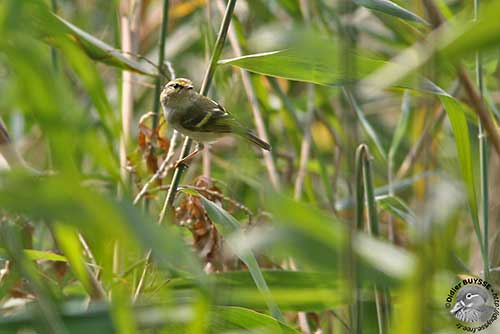
CALLS AND SONGS: SOUNDS BY XENO-CANTO
The Yellow-browed Warbler’s most common call is a plaintive, high-pitched, rising “tswe-eeet” or “tsuee-eep”.
The short, tiny song is a rapid repetition of the call note “tsee-oo tsee-oo eep-tsee-eep”. In late winter, some wintering birds may give bursts of song, prior to the spring.

BEHAVIOUR IN THE WILD:
The Yellow-browed Warbler feeds almost exclusively on small insects and other invertebrates. Insects include various species such as Ephemeropterans, damselflies and dragonflies, cockroaches, Hemipterans (adults and larvae), Nemoptera, Lepidopterans (adult and larvae), Dipterans, ants, wasps, bees, Coleopterans and spiders. It also takes ticks, small crustaceans and small molluscs. Some seeds can be added sometimes.
The Yellow-browed Warbler forages often in groups, but also alone or in pairs. Insects are usually caught by sallies, but the bird also hovers in order to glean insects from the underside of the leaves and the vegetation.
This species is known for its foraging technique: it beats its wings in attempt to flush prey. It is very agile and active while searching for prey in trees and in the undergrowth, and it may sometimes forage on the ground.
At the beginning of the breeding season, the male establishes the territory by singing loudly from perch, always the same in tree canopy. It sings with quivering wings.
The Yellow-browed Warbler appears to be semi-colonial when breeding. The groups may vary in size with up to 50 pairs fairly close to each other, but also in single groups of 3 nesting pairs, according to the location.
From a study, it appears that males which have their territories in the centre of the group are sexually more attractive for females than other males, as the birds are clustered in groups. Each pair has its own territory and defends it. However, further validation is needed.
Males are usually more numerous than females in these aggregations, involving some polygynous males, but they are usually mainly monogamous.
They are territorial and intimidation displays at the boundaries of the territories are common. The male flicks the wings frequently. It also sings with drooped wings, and this behaviour is used both against other males at territory borders, and also with its mate. Rival males threatened each other while sitting face to face at 2-3 metres of distance. Long chases and conflicts can be common.
The Yellow-browed Warbler is migratory. It leaves the breeding grounds between mid-August and late September, with some variations according to the range.
The return migration occurs in late March and early April, with arrival in late May/early June.
The flight is agile with several active wingbeats interspersed with short glides.
REPRODUCTION OF THIS SPECIES:
The breeding season takes place during summer, from June/July to early August. The Yellow-browed Warbler produces a single brood per season.
The nest is built by the female alone and she chooses the nest-site too. She often calls while approaching the nest-site with new material. The nest can be placed in holes between roots or among Betula fusca shrubs, at 1,8/2 metres above the ground, or hidden in tussocks. It is often built under branches or overhanging vegetation, and only the entrance is visible. It is close to the singing post of the male, tree or high bush.
The nest is made with dry grasses, pine needles, moss, pieces of rotting wood, plant fibres and animal hair.
The female lays 2-4 eggs and incubates alone during 11-14 days. At hatching, the downy chicks are brooded by the female, but they are fed by both parents. They fledge about 12-13 days after hatching, but they still depend on parents for food during 12-13 days. Replacement clutch may occur following egg predation.
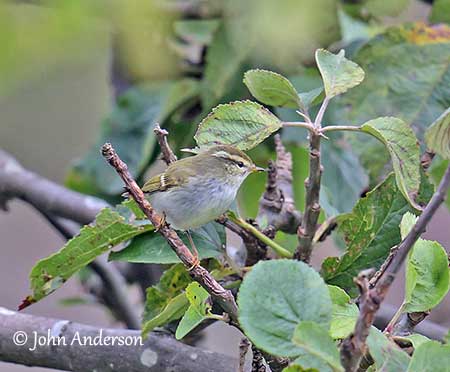
PROTECTION / THREATS / STATUS:
The Yellow-browed Warbler is vulnerable to predators during the nesting period. The nests are predated by crows, weasels, foxes and snakes that take both eggs and chicks.
The Yellow-browed Warbler is usually common and widespread throughout the range.
The global population size is unknown, but in Europe, there are 5,000/35,000 breeding pairs, equating to 15,000/105,000 individuals, and Europe forms <5% of the global range.
This population appears stable and the Yellow-browed Warbler is currently evaluated as Least Concern.